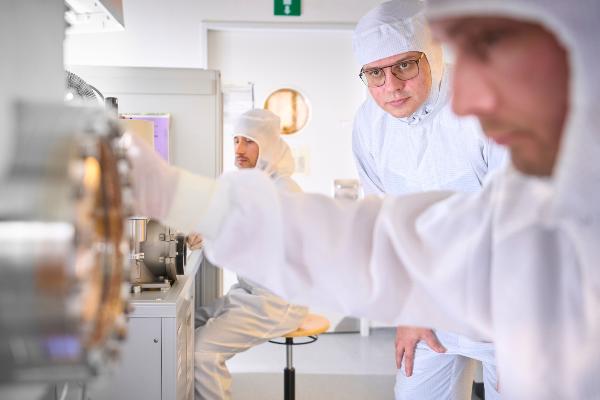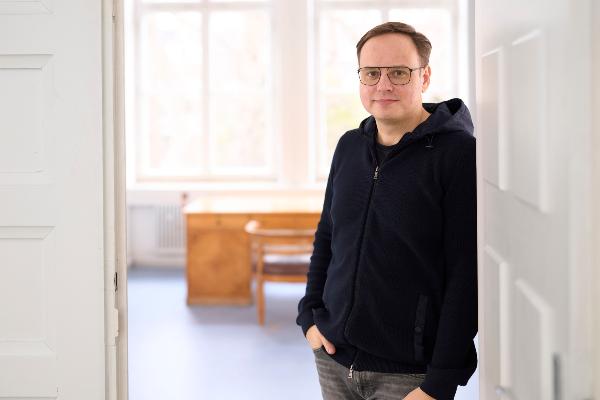If you twist two graphene layers at a certain angle to each other, you obtain a superconducting material, which is capable of a variety of further exotic quantum phases. Only discovered in 2018, this magic-angle twisted graphene is an ideal candidate for novel quantum devices. However, we still do not understand in detail how this unusual behavior comes about.
An international team led by LMU physicist Dmitri Efetov has made progress in this area: Using measurements of thermal conductivity, the researchers have demonstrated that the twisted graphene bilayers behave like so-called heavy-fermion metals. This class of crystalline materials has long been known and there are established theoretical models to describe their behavior. Now this knowledge can be applied to magic-angle twisted graphene, which could help scientists develop novel applications.
Prof. Dmitri Efetov (center) with colleagues in his laboratory at LMU
© Jan Greune / LMU
A form of carbon just one atomic layer thick, graphene is a so-called two-dimensional material. It has numerous fascinating properties, not least because its electrons become massless Dirac fermions that move at extreme speeds. “The corresponding research field is well established at this point; the Nobel Prize was given for work on graphene in 2010,” notes Efetov.
But magic-angle twisted graphene is a different story. “Scientists discovered the material just seven years ago and we do not fully understand its behavior yet.” And yet the basic concept is relatively simple: “You just take two layers of graphene, stack one on top of the other, and give them a little twist so they’re at an angle to each other,” explains Efetov, member of the Cluster of Exzellence MCQST.
Sophisticated manufacturing
When it comes to the specifics, however, manufacturing them is a tricky business requiring extreme precision. The layers have an edge length of one micrometer, for example, and the twist angle must be exactly 1.1 degrees, no more and no less – the ‘magic angle.’ Efetov and his team needed several years to establish a truly reliable production process.
When the layers are correctly twisted, their electrons interact with each other very strongly. “The electrons slow down as a result and behave as a collective,” says Efetov. This makes the material superconductive – in other words, electricity flows through it without resistance. In contrast to other superconductors, the number of electrons that contribute to this state is very low. As such, even a single low-energy photon can significantly disrupt the superconductive state. The team exploited this property in 2024 to detect low-energy photons from the infrared range. “This was the first application of the material,” observes Efetov.
LMU physicist Dmitri Efetov, here in his office at LMU, investigates the behavior of twisted layers of graphene.
© Jan Greune / LMU
In the long run, gaining a fundamental understanding of the material should lead to the development of further applications.
Dmitri Efetov
Sensitive single-photon detector
Depending on temperature, magnetic field, and the applied voltage, it is possible to generate a variety of other correlated states, which give the material other properties. “There was a hypothesis that this behavior corresponds precisely with that of heavy-fermion systems,” says Efetov. In these systems, there are two types of electrons: ‘heavy’ electrons that can be easily localized and ‘light’ ones which are very mobile: “The first kind are rooted to the spot, as it were, while the others dart through the lattice,” he explains. Both types of electrons interact strongly with each other, however, producing the unusual behavior of heavy-fermion metals.
Before now, scientists have lacked experimental proof that the same thing occurs in bilayers of graphene twisted at the magic angle. So the team looked around for an experiment to test the hypothesis and alighted on measurements of thermal conductivity: “This value responds much more sensitively to the type of electrons than electrical resistance. For light electrons you get a very strong signal and for heavy electrons you get a very weak one,” explains the expert.
Using a laser light, the researchers heated up certain sections of the graphene layers. “The ‘hot’ electrons flowed into colder regions, generating a sort of thermally induced photocurrent,” says Efetov. The researchers fitted tiny electrodes to read the resulting voltage differences. In accordance with the prediction, they observed completely different behavior of the material at low temperatures compared to high ones. This can be explained by the different interaction between light and heavy electron states – just like in heavy-fermion metals.
“Our results thus connect the field of heavy-fermion systems with that of twisted graphene bilayers,” says Efetov. As a result, scientists could use established methods to predict the behavior of the magic-angle twisted graphene. “In the long run, gaining a fundamental understanding of the material should lead to the development of further applications,” hopes the physicist.



